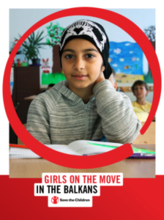Executive Summary
Girls on the move face a multitude of often gender-specific challenges during their migration journey and programming adjustments are needed to appropriately respond to their needs and fulfil their rights. In the data collected in this research, no evidence was found of specific migration routes in the Balkans being preferred by families travelling with girls, although it did suggest a greater level of preparation, resulting in somewhat slower mobility of families with children and of unaccompanied and separated girls. The findings confirmed the differences in the proportion of girls, particularly unaccompanied girls, accommodated in Greece, when compared with Serbia and Bosnia and Herzegovina, with much higher proportion of girls present in Greece than in the Balkans transit countries, suggesting a degree of risk aversion by the families when deciding whether to continue their migration journey, but also an inadequate identification process for unaccompanied girls.
The push factors identified for families and unaccompanied girls to start the migration journey were quite complex, with safety and the prevalence of sexual and gender-based violence mentioned as two predominant factors in the decision to move. Having daughters often served as an additional push factor for leaving, including to prevent forced marriages, escape domestic violence, or ensure access to education for the girls.
Families with children and unaccompanied girls emphasized the importance of travelling in groups and choosing a reliable smuggler, even if this meant waiting longer in some countries of transit. Families and girls reported having very little information about the journey ahead of time, and limited access to information during the journey. They relied predominantly on their family or other refugees and migrants, mostly women, and on those who had recently reached the destination, but also on the smugglers, for information. Findings show that families travelling with children possibly have a different decision-making process from refugees and migrants who travel without families. The findings from Greece indicate that travelling with children or as single women tended to be more expensive as these travellers sought to ensure some “safety” during the journey.
According to the interview findings in Serbia, having girls in the family has not proven to be a factor with a significant impact on the choice of route.
The importance of a strong bond between mothers and daughters, with mothers ensuring their daughters were consulted and protected emerged as a strong finding.
Girls themselves often struggled to articulate their migration stories, but they still reported personal experiences with violence, including rape and sexual violence, exploitation, neglect, abandonment during dangerous situations, or deceit by smugglers. Girls were often seemingly absent from decision making, but were still involved in a less obvious way, including through consultation with mothers and other women, and with noticeable differences in agency between younger and older girls, unaccompanied and accompanied girls.
Experiences of girls on the move were different from one country of transit to another, with widely ranging availability of services and gaps in systems of protection. There was also a gap in access to learning when comparing to boys on the move in Serbia and BiH, and fewer or no activities or schooling opportunities were available to older girls in comparison to younger girls in these two countries. Absence of friends, few targeted activities and limited access to school, coupled with a lack of interpreters, including women interpreters, was described as contributing to the feelings of loneliness among girls. Accommodation options for girls were limited, and although efforts to ensure separate spaces for girls and families were reported for all three countries covered, the situation on the ground remained challenging.
Comprehensive data on girls, disaggregated by age and ethnicity was generally not available in any of the three countries and this contributed to the greater invisibility of girls and their risks.
This report is part of a global research series on girls on the move.

